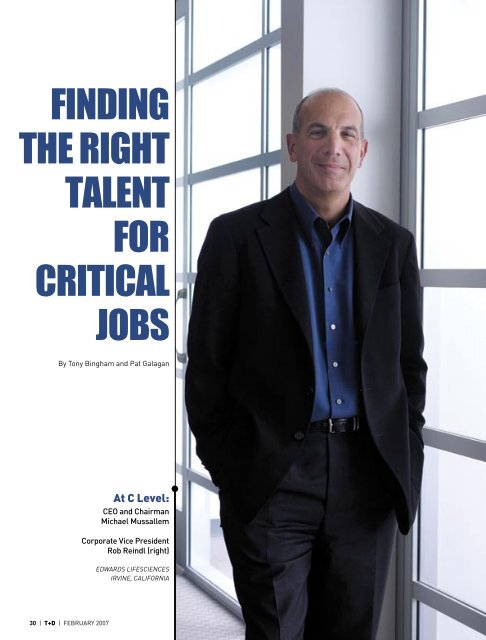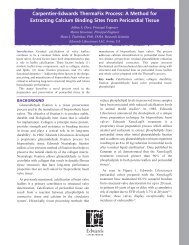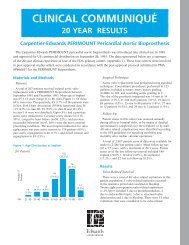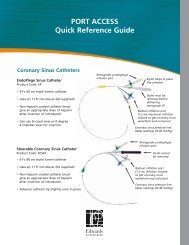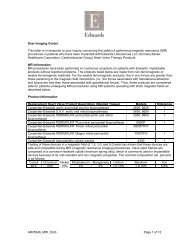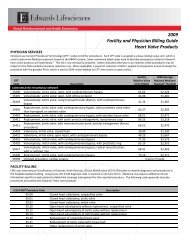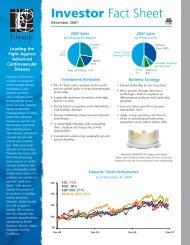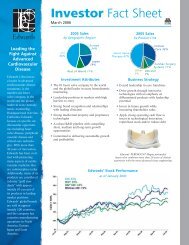Finding the right tALent FOr CritiCAL JOBS - Edwards Lifesciences
Finding the right tALent FOr CritiCAL JOBS - Edwards Lifesciences
Finding the right tALent FOr CritiCAL JOBS - Edwards Lifesciences
Create successful ePaper yourself
Turn your PDF publications into a flip-book with our unique Google optimized e-Paper software.
<strong>Finding</strong><br />
<strong>the</strong> <strong>right</strong><br />
TALENT<br />
FOR<br />
CRITICAL<br />
<strong>JOBS</strong><br />
By Tony Bingham and Pat Galagan<br />
At C Level:<br />
CEO and Chairman<br />
Michael Mussallem<br />
Corporate Vice President<br />
Rob Reindl (<strong>right</strong>)<br />
<strong>Edwards</strong> <strong>Lifesciences</strong><br />
Irvine, California<br />
30 | T+D | February 2007
<strong>Edwards</strong> <strong>Lifesciences</strong> is<br />
<strong>the</strong> top heart valve company in <strong>the</strong><br />
world in terms of sales and a leader<br />
in products for <strong>the</strong> treatment of advanced<br />
heart disease. Its sales in 2005<br />
were $998 million. Incorporated in<br />
2000 when it separated from Baxter<br />
International, it has held its own<br />
against much larger players, such as<br />
Medtronic, Johnson & Johnson, and<br />
Boston Scientific.<br />
Part of its strong performance is<br />
due to its focus on patients ra<strong>the</strong>r<br />
than on what is termed “interventional<br />
cardiology,” which is a branch<br />
of cardiology that deals specifically<br />
with <strong>the</strong> ca<strong>the</strong>ter-based treatment of<br />
heart disease. Heart disease affects<br />
22 million people—1 in 12 adults—in<br />
<strong>the</strong> United States.<br />
T+D talked with CEO and Chairman<br />
Michael Mussallem and Corporate<br />
Vice President Rob Reindl about<br />
<strong>the</strong>ir strategic approach to talent<br />
management.<br />
Photo by Mark Robert Halper<br />
February 2007 | T+D | 31
At C Level: Michael Mussallem and Rob Reindl<br />
Q. <strong>Edwards</strong> <strong>Lifesciences</strong> has a<br />
process for identifying positions<br />
that are critical for success—<strong>the</strong><br />
essential jobs. Why does this process<br />
of identifying critical jobs merit <strong>the</strong><br />
time and attention of <strong>the</strong> CEO<br />
Mussallem: The concept of critical jobs is<br />
something we learned from a 1997 McKinsey<br />
& Company survey, “War for Talent,” and<br />
it just made sense to me. One of <strong>the</strong> most<br />
important elements that you need to make<br />
an organization work is a properly executed<br />
strategy. A well-articulated strategy really<br />
lays out <strong>the</strong> priorities of <strong>the</strong> organization so<br />
you can allocate <strong>the</strong> proper resources to get<br />
<strong>the</strong> job done.<br />
However, once you lay out your top priorities,<br />
you realize that if you’re going to be successful,<br />
you need to have <strong>the</strong> best talent. You<br />
need A players in <strong>the</strong> most critical jobs, and<br />
those critical jobs are not necessarily just a<br />
slice across <strong>the</strong> top of <strong>the</strong> organization.<br />
If, for example, it is very critical to innovate<br />
in a particular area, <strong>the</strong>n being able to<br />
have <strong>the</strong> technical talent or <strong>the</strong> innovation<br />
talent to go deep in that area might be of<br />
critical importance. Or, if it is about bringing<br />
a product to <strong>the</strong> marketplace, <strong>the</strong>re is nothing<br />
more important to <strong>the</strong> company than<br />
having deep operational talent in that space.<br />
You could have critical jobs deep in <strong>the</strong> organization<br />
in many different roles. It might<br />
be a supervisor, an engineer, or a scientist,<br />
depending on <strong>the</strong> strategy.<br />
We said, “Let’s force ourselves to decide<br />
what <strong>the</strong> critical jobs are.” We keep a list<br />
that evolves as <strong>the</strong> strategy of <strong>the</strong> company<br />
evolves, and I am heavily involved in it.<br />
Reindl: A critical job doesn’t always stay a<br />
critical job, and if one is removed from <strong>the</strong><br />
list it’s not necessarily because of performance.<br />
A critical job is not about <strong>the</strong> person<br />
who holds it; it’s about <strong>the</strong> job and its association<br />
with <strong>the</strong> strategy. When we identify<br />
a job as critical, we tell <strong>the</strong> person in <strong>the</strong> job<br />
it may not always be critical. At <strong>the</strong> moment,<br />
we have approximately 70 critical jobs out<br />
of a total of 1,200.<br />
Mussallem: Discussions about this with our<br />
senior leaders are very interesting because<br />
when you first get into a conversation about<br />
critical jobs, <strong>the</strong> tendency is to want to look<br />
at <strong>the</strong> top of <strong>the</strong> organization and to call a<br />
critical job by <strong>the</strong> incumbent’s name. So, we<br />
force names out of <strong>the</strong> discussion and just<br />
look for <strong>the</strong> most important jobs. Then we<br />
get tough about discussing whe<strong>the</strong>r <strong>the</strong> <strong>right</strong><br />
people are in those jobs.<br />
Q. Can you describe <strong>the</strong> process<br />
Reindl: Mike and I do 14 talent reviews every<br />
year. Each one lasts four or five hours. We<br />
start with <strong>the</strong> business imperatives for <strong>the</strong><br />
function or region. The business leader for<br />
<strong>the</strong> function, region, or business unit and his<br />
HR person are in <strong>the</strong> room, with a bottomup<br />
review that was done prior to <strong>the</strong> meeting.<br />
We talk about how <strong>the</strong> unit is organized<br />
to meet its business imperatives and <strong>the</strong><br />
critical jobs associated with that. We look at<br />
how people are performing, <strong>the</strong> high potentials,<br />
and <strong>the</strong> key technical talent associated<br />
with strategy.<br />
Mussallem: Rob and I really get into <strong>the</strong> discussion<br />
of whe<strong>the</strong>r or not a job is critical for<br />
<strong>the</strong> company’s strategy. People come with<br />
<strong>the</strong>ir own lists and say, “Wait a second. This<br />
job may not be critical to <strong>the</strong> organization,<br />
but it’s critical to me.” There is a high level of<br />
intensity in <strong>the</strong>se discussions and that has a<br />
great effect on <strong>the</strong> whole company.<br />
Reindl: Mike and I lose sleep if good performance<br />
is not happening in a critical job or if<br />
one of <strong>the</strong>m suddenly becomes open.<br />
Mussallem: We expect a call if <strong>the</strong>re is<br />
anything that threatens a critical job so that<br />
we can get involved.<br />
Reindl: In most organizations, if a critical job<br />
opens up, people tend to look to resources<br />
in <strong>the</strong>ir own areas to fill <strong>the</strong> job. But we may<br />
know of high-potential employees in o<strong>the</strong>r<br />
parts of <strong>the</strong> organization.<br />
32 | T+D | February 2007
Q. What impact does this process<br />
have on organizational performance<br />
Mussallem: It’s hard to draw a direct correlation.<br />
Because of our attention to this, we<br />
don’t have important jobs that sit open. I like<br />
to think it helps us stay on our timelines and<br />
deliver better results. It all comes back to <strong>the</strong><br />
results of your company. By and large, I think<br />
<strong>the</strong> company has been successful. We have<br />
consistently grown our top line, and we are<br />
delivering on our imperatives. I think that<br />
it all correlates to having <strong>the</strong> <strong>right</strong> people in<br />
<strong>the</strong> <strong>right</strong> jobs at <strong>the</strong> <strong>right</strong> time.<br />
Q. When you look at your industry<br />
as a whole or <strong>the</strong> company in particular,<br />
do you have any sense of <strong>the</strong>re<br />
being a skills gap<br />
Mussallem: In our company, yes, and it<br />
comes back to our strategy. For example,<br />
we are evolving into a company that is<br />
going to drive more innovation and apply<br />
more technology to unmet patient needs.<br />
And that is going to require us to do more<br />
clinical studies than in <strong>the</strong> past to be able<br />
to demonstrate <strong>the</strong> value of our products.<br />
So as we increase <strong>the</strong> importance of clinical<br />
studies, we see that we don’t have a strong<br />
enough clinical research function. We need<br />
more and better talent in that area, so we<br />
have made that a strategic priority.<br />
Reindl: Ano<strong>the</strong>r example is our intention to<br />
have double-digit growth on a consistent<br />
basis. To do that, you can ei<strong>the</strong>r build from<br />
within or acquire from <strong>the</strong> outside. Ei<strong>the</strong>r<br />
way, <strong>the</strong> market development role is really<br />
important, and we need great market development<br />
resources on <strong>the</strong> front end to help us<br />
think through that.<br />
“If you’re going to be<br />
successful, you need to<br />
have <strong>the</strong> best talent.”<br />
Q. <strong>Edwards</strong> <strong>Lifesciences</strong> is a publicly<br />
traded company. When you talk<br />
to market analysts and investment<br />
bankers, do <strong>the</strong>y understand <strong>the</strong><br />
value of having <strong>the</strong> <strong>right</strong> talent in <strong>the</strong><br />
<strong>right</strong> place at <strong>the</strong> <strong>right</strong> time<br />
Mussallem: I think <strong>the</strong> short answer is “not directly.”<br />
For <strong>the</strong> most part, <strong>the</strong>y put <strong>the</strong> greatest<br />
premium on <strong>the</strong> delivery of results. The<br />
process for getting <strong>the</strong>re is interesting to<br />
<strong>the</strong>m, but not as interesting as <strong>the</strong> ability to<br />
deliver results consistently. Now, having said<br />
that, I have been in several interviews with<br />
insightful investors who ask questions about<br />
how we manage and think because <strong>the</strong>y want<br />
an indication of whe<strong>the</strong>r or not <strong>the</strong>y trust our<br />
management and <strong>the</strong> way we solve problems.<br />
Occasionally, some will get into <strong>the</strong> talent issue,<br />
but I would say <strong>the</strong>y are <strong>the</strong> minority.<br />
Q. What kind of metrics do you use<br />
to tell you if your talent management<br />
efforts are working<br />
Reindl: From a talent acquisition perspective,<br />
we feel that if jobs are open longer than<br />
50 days, that’s a concern. Some say that can<br />
send you down a path of hiring substandard<br />
talent because you are trying to beat <strong>the</strong><br />
clock, but we trust our hiring managers not<br />
to do that.<br />
We have a metric that says we want to<br />
see at least one—if not two—successors for<br />
every critical job. During talent reviews, we<br />
expect managers to be accountable for that.<br />
We have a metric that says no one who is<br />
high potential or key talent should be paid<br />
below <strong>the</strong> 19th percentile of her estimated<br />
market value. Putting a metric on that helps<br />
remind people that it’s important.<br />
Controlling turnover is huge for us, especially<br />
for top talent, so our metric is that<br />
turnover for that group is less than 6 percent<br />
annually. The top talent pool includes all critical<br />
jobs and high potentials. That includes<br />
some nonleadership technical talent whose<br />
departures would really hurt us. Managing<br />
turnover is part of performance evaluations.<br />
February 2007 | T+D | 33
At C Level: Michael Mussallem and Rob Reindl<br />
Q. It’s interesting that you haven’t<br />
mentioned a measure of investment in<br />
employee training and development.<br />
Reindl: During talent reviews, we definitely<br />
expect people to come in with development<br />
plans for high potentials or people in critical<br />
jobs. We know that big companies can spend<br />
millions of dollars on training and development,<br />
but we are relatively small—just $1 billion<br />
in sales. One thing a smaller company can<br />
do is to make sure to rotate people and give<br />
<strong>the</strong>m many different job experiences. That<br />
doesn’t cost a lot of money. We also relocate<br />
people around <strong>the</strong> globe to get specific experience,<br />
such as performance and learning.<br />
We invest <strong>the</strong> most in job rotations, and<br />
we have just instituted an extensive leadership<br />
development curriculum, which is delivered<br />
mostly as e-learning. We also send some<br />
high-potential people to executive business<br />
management programs.<br />
Q. Your approach to talent management<br />
is to look at key positions<br />
ra<strong>the</strong>r than key individuals. But <strong>the</strong>re<br />
must be people whom you don’t want<br />
to lose who are not in critical positions.<br />
So how do you deal with that<br />
Mussallem: We get so excited about critical<br />
jobs that it probably sounds like it’s all about<br />
<strong>the</strong> positions and not about <strong>the</strong> people, but<br />
that’s not really <strong>the</strong> case. In tandem with<br />
deciding what <strong>the</strong> critical jobs are, we have<br />
our eyes on talent. We identify people who<br />
are high potential and watch <strong>the</strong>m very, very<br />
closely. We go out of our way to make sure<br />
that we don’t have our best people in jobs that<br />
aren’t critical. We want our best people to get<br />
into <strong>the</strong> jobs that have <strong>the</strong> most impact not<br />
only for <strong>the</strong> contributions <strong>the</strong>y make to <strong>the</strong><br />
company, but because it gives <strong>the</strong>m a chance<br />
to grow in a high-visibility, high-impact role. I<br />
think it accelerates <strong>the</strong>ir development.<br />
Q. What are <strong>the</strong> key attributes you<br />
look for in your leaders<br />
Reindl: We divide <strong>the</strong> list of competencies<br />
into three different buckets: leadership,<br />
technical, and traits. There are six leadership<br />
competencies, including innovation<br />
and entrepreneurship. We also look for<br />
specific traits that we believe contribute to<br />
success in our unique culture. We came up<br />
with <strong>the</strong>m after hiring for some important<br />
jobs and finding that <strong>the</strong> people only lasted<br />
about six months.<br />
One trait is “in-check ego.” There are a<br />
lot of smart people here, so you have to be<br />
pretty self-confident to be successful. On <strong>the</strong><br />
o<strong>the</strong>r hand, if that turns into arrogance, you<br />
won’t last very long.<br />
Ano<strong>the</strong>r trait we look for is passion for<br />
<strong>the</strong> work and <strong>the</strong> company. We’re developing<br />
devices that are going to save people’s lives.<br />
If you don’t have a passion for doing that in<br />
this environment, you are just not going to<br />
last very long.<br />
A third trait is what we call “creative debate.”<br />
It’s one we uncovered by interviewing<br />
some of <strong>the</strong> mavericks in our senior<br />
leadership. It means that you need to be<br />
able to debate things no matter your level,<br />
function, or expertise. And it means that if<br />
someone puts a tough issue on <strong>the</strong> table,<br />
everyone, including experienced people,<br />
need to listen.<br />
What we want to achieve from such debates<br />
is a more creative idea than a group<br />
might have started out with, because out of<br />
creativity comes innovation, and innovation<br />
is critical for this company’s future. Creative<br />
debate goes two ways: It’s <strong>the</strong> ability to bring<br />
up an issue and speak with confidence<br />
about it, but it is also <strong>the</strong> ability to listen to<br />
o<strong>the</strong>r people.<br />
34 | T+D | February 2007
Mussallem: It means having enough self-confidence<br />
to be able to confront people at a<br />
higher level or those with more experience<br />
than you have, but to do it in a nondefensive<br />
way. To remind us to accommodate creative<br />
debate, we have a visual symbol—a tornado<br />
in a small acrylic pyramid—on our desks and<br />
in our conference rooms.<br />
Reindl: We consider creative debate part of<br />
employee engagement. In our most recent<br />
survey, employee engagement went up: 87<br />
percent of our people scored a four or five<br />
(on a five-point scale) on measures of engagement.<br />
One question on <strong>the</strong> survey asks<br />
if it is “safe to speak up in this company”<br />
We improved by 6 percentage points over<br />
<strong>the</strong> prior year, which is statistically significant.<br />
Are we <strong>the</strong> best at it yet No way, but<br />
we are improving.<br />
Q. You’ve said that <strong>the</strong> culture<br />
here is unique. Describe <strong>the</strong> culture<br />
you’ve tried to create and how it’s different<br />
from Baxter International, <strong>the</strong><br />
company this one came from.<br />
Mussallem: There are many good things that<br />
we carried over from <strong>the</strong> Baxter culture, but<br />
let me focus on some of <strong>the</strong> unique things<br />
that we wanted built into this culture.<br />
In an effort to become more innovative<br />
and to create value by filling unmet patient<br />
needs with new solutions, we needed to increase<br />
our risk profile. We needed to be able<br />
to take chances and to be less risk averse.<br />
That meant we needed a culture that was not<br />
a blaming culture, but one that was a learning<br />
culture. So, we spent a lot of time talking<br />
about this and came up with <strong>the</strong> phrase<br />
“Don’t blame; learn.”<br />
We recognized that in <strong>the</strong> process of making<br />
decisions, we were critical about our<br />
past. We would assign blame, and <strong>the</strong>re was<br />
punishment associated with that. It created<br />
more risk aversion. People were less likely<br />
to offer solutions or come forward with<br />
bold ideas because <strong>the</strong> punishment for failure<br />
was severe. We asked, “What if we had<br />
a culture where a person could admit that<br />
things weren’t going well and be thanked for<br />
acknowledging it, so that <strong>the</strong>re was <strong>the</strong> opportunity<br />
to learn and correct our course<br />
before things got really serious”<br />
We also wanted to create an ownership<br />
culture. This is where our small size really<br />
works for us. People are able to be 10 times<br />
more valuable here than <strong>the</strong>y might be in<br />
a larger company. You can really move <strong>the</strong><br />
needle here. To help create an ownership<br />
culture, we try to put stock in <strong>the</strong> hands<br />
of all employees and tell <strong>the</strong>m, “Treat <strong>the</strong><br />
company like you own it, not like you just<br />
work here.”<br />
We also put a tremendous amount of focus<br />
on <strong>the</strong> patients who benefit from our products,<br />
which helps satisfy <strong>the</strong>ir physicians. We<br />
serve many constituencies—our investors,<br />
our customers, and our employees—but we<br />
feel that if we always do good things for patients,<br />
<strong>the</strong>n we will align in such a way that<br />
it will all work. We can create a great place to<br />
work because when we satisfy patients, <strong>the</strong><br />
financial results follow.<br />
Reindl: I would like to add that <strong>the</strong> culture<br />
here is influenced by what <strong>the</strong> CEO brings to<br />
<strong>the</strong> table. Mike is a high-relationship person<br />
who treats o<strong>the</strong>rs with respect, listens, and<br />
is not arrogant about power. People imitate<br />
what <strong>the</strong>y see.<br />
Q. Talk a bit more about what you<br />
mean by having a learning culture.<br />
How does that play out<br />
Mussallem: I feel that <strong>the</strong> greatest opportunities<br />
for us relate directly to our ability to<br />
learn. The world is moving very fast, especially<br />
<strong>the</strong> world of medicine. To keep doing<br />
what worked in <strong>the</strong> past is potentially a<br />
formula for disaster for us. So our ability to<br />
recognize new patterns and adapt quickly,<br />
to take advantage of situations as <strong>the</strong>y occur,<br />
and to respond to <strong>the</strong>m better than o<strong>the</strong>rs<br />
becomes more important all <strong>the</strong> time. Our<br />
ability to learn fast, implement, and execute<br />
directly correlates to our long-term success.<br />
Reindl: We also make a conscious effort to<br />
learn from <strong>the</strong> young talent that we bring<br />
February 2007 | T+D | 35
At C Level: Michael Mussallem and Rob Reindl<br />
in. They know something that we don’t, and<br />
<strong>the</strong>y bring something different to <strong>the</strong> table.<br />
So, we recruit <strong>the</strong>m in a big way. We focus<br />
on engineering talent because we feel this is<br />
where we need innovation and fresh ideas.<br />
We go to <strong>the</strong> top engineering schools to interview<br />
people. We <strong>the</strong>n invite 50 recent<br />
graduates for a weekend at our company.<br />
From that group, we select a half dozen for<br />
our technical development program, in<br />
which <strong>the</strong>y rotate through all <strong>the</strong> engineering<br />
units in <strong>the</strong> company—quality engineering,<br />
manufacturing engineering, and so on.<br />
They take part in product development projects<br />
and may even have a marketing role. At<br />
<strong>the</strong> end of 18 months, <strong>the</strong>y get a job some<br />
place in that prior rotation.<br />
Mussallem: That program is <strong>the</strong> extension of<br />
a fundamental belief that if we want to be<br />
innovative, we need to study what makes a<br />
company innovative. Where does innovation<br />
come from We found that it is <strong>the</strong> beginner’s<br />
mindset that turns out to be very important.<br />
Being steeped in experience isn’t necessarily<br />
<strong>the</strong> natural formula for success when you<br />
are talking about innovation. The beginner’s<br />
mindset looks at problems for <strong>the</strong> first time<br />
in a new way and can produce some of <strong>the</strong><br />
most interesting ideas. We felt that if we<br />
were really going to have a learning culture,<br />
we needed to create an environment for really<br />
new and fresh minds. That’s not just agerelated.<br />
It includes people with different<br />
backgrounds and skill sets.<br />
Q. Sustaining an innovative culture<br />
is pretty challenging. What do you do<br />
to foster that<br />
Mussallem: We try to recognize and celebrate<br />
innovation when it happens to signal that it<br />
is truly valued here. And we do not punish<br />
for trying and failing. There is reward and<br />
recognition for reaching high. Earlier, we<br />
talked about not having a blaming culture.<br />
This is an important component of an innovative<br />
culture.<br />
And that is a test for us. You can imagine<br />
that if someone comes in with bad news,<br />
<strong>the</strong> way we react sends tremendous signals.<br />
Sometimes you really have to bite your<br />
tongue and say, “Thanks for helping us learn<br />
from that failure.” But that is <strong>the</strong> real deal. If<br />
you can stand up to that test day after day<br />
and continue to encourage yourself to take<br />
<strong>the</strong> chances—to make <strong>the</strong> investments, to<br />
step forward—that sends signals through <strong>the</strong><br />
organization. If we behave that way, <strong>the</strong>re<br />
is a good chance we can drive innovation<br />
through our culture.<br />
Q. During this interview, <strong>the</strong> two<br />
of you have often completed each<br />
o<strong>the</strong>r’s thoughts. Mike, how would<br />
you characterize your working relationship<br />
with Rob<br />
Mussallem: It’s probably apparent from this<br />
discussion that I get focused on strategy and<br />
on <strong>the</strong> business. But bringing that to life is<br />
something I don’t necessarily have <strong>the</strong> skills<br />
to do. So, I have a partner in Rob. His office is<br />
<strong>right</strong> next to mine, and I probably drive him<br />
crazy. He has a great training and development<br />
background and <strong>the</strong> ability to apply <strong>the</strong><br />
tools of his profession to business issues.<br />
Here at <strong>Edwards</strong> <strong>Lifesciences</strong>, we are serious<br />
about our people. Every company says<br />
that, but doing it makes <strong>the</strong> difference. Our<br />
company is small enough that we can engage<br />
personally with our leaders about our<br />
issues. Rob and his team are great partners<br />
in driving that.<br />
Reindl: Thanks, I appreciate that you said<br />
that. When Mike asked me to be head of HR,<br />
I was <strong>the</strong> global head of training and development<br />
for Baxter. I was not steeped in compensation<br />
or benefits, and I asked Mike if he<br />
was sure he wanted me for <strong>the</strong> job. He said,<br />
“You can hire <strong>the</strong> best people for that. I want<br />
someone with a development mindset as <strong>the</strong><br />
head of HR.” That tells you a lot about where<br />
his head is when it comes to people. t+d<br />
Michael Mussallem and Rob Reindl were interviewed<br />
by Tony Bingham, president and CEO<br />
of ASTD, and Pat Galagan, executive editor of<br />
ASTD; pgalagan@astd.org.<br />
36 | T+D | February 2007
Growing Talent at<br />
<strong>Edwards</strong><br />
Lifescie<br />
The corporate vice president<br />
explains <strong>the</strong> Company’s philosophy<br />
for talent management.<br />
By Rob Reindl<br />
38 | T+D | February 2007
The seeds of talent management at Corporate philosophy<br />
<strong>Edwards</strong> <strong>Lifesciences</strong> took hold before When <strong>Edwards</strong> <strong>Lifesciences</strong> became a<br />
<strong>the</strong> company existed in name.<br />
publicly traded company, Mussallem,<br />
Formerly <strong>the</strong> cardiovascular<br />
who had become CEO and chairman,<br />
division of Baxter Healthcare, <strong>Edwards</strong> asked me to run <strong>the</strong> company’s human<br />
spun off as an independent company resources department. Mussallem’s<br />
in 2000. In 1998, Baxter initiated a priority for <strong>the</strong> position was to nurture<br />
study—spearheaded by McKinsey & talent, so we sat down immediately<br />
Company—that identified positions to take stock of <strong>the</strong> company’s talent,<br />
that were essential to attaining <strong>the</strong> assess <strong>the</strong> corporate structure,<br />
corporation’s business imperatives. and begin to build a culture that<br />
Along with McKinsey, Mike<br />
prized innovation, risk taking, and<br />
Mussallem, who was president of <strong>the</strong> development.<br />
cardiovascular division at <strong>the</strong> time,<br />
A new company philosophy was one<br />
and I engaged in a rigorous bottomup<br />
analysis of <strong>the</strong> entire division to sions. Mussallem, a charismatic speak-<br />
of <strong>the</strong> first products of those early ses-<br />
identify <strong>the</strong> jobs that were critical to er, argued passionately that <strong>Edwards</strong><br />
achieving <strong>the</strong> company’s objectives. should be defined as a trusted partner<br />
However, it wasn’t <strong>the</strong> top 50 to 100 of customers and patients, acting “boldly,<br />
vice presidents at Baxter that McKinsey,<br />
Mussallem, and I discovered to be behalf of <strong>the</strong> people who are fighting<br />
decisively, and with determination on<br />
uniquely essential, but positions at both cardiovascular disease.”<br />
<strong>the</strong> lower and upper echelon, as well as With <strong>the</strong> <strong>right</strong> talent in <strong>the</strong> <strong>right</strong><br />
some in between. Those critical positions<br />
include a variety of roles within lieved <strong>Edwards</strong> could respond to previ-<br />
place at <strong>the</strong> <strong>right</strong> time, Mussallem be-<br />
<strong>the</strong> organization, such as jobs in engineering,<br />
manufacturing, accounting, as it met its customers’ needs with high<br />
ously unmet patient needs. And as long<br />
sales, and marketing.<br />
quality solutions, <strong>the</strong> company would<br />
As business imperatives evolve, so satisfy its own employees and investors.<br />
do <strong>the</strong> critical positions within <strong>the</strong><br />
<strong>Edwards</strong>’s credo has remained unchanged,<br />
and while it has provided company.<br />
nces<br />
As a result, we recognized<br />
<strong>the</strong><br />
that corporate learning and development<br />
efforts had to provide generations<br />
of employees, across all disciplines,<br />
with <strong>the</strong> skills and knowledge to adapt<br />
and grow with <strong>the</strong> often volatile medical<br />
device industry.<br />
necessary direction for <strong>the</strong> company,<br />
Mussallem wanted a more succinct set<br />
of goals that could easily be articulated<br />
by every employee. He and his leadership<br />
team came up with <strong>Edwards</strong>’s aspirations—a<br />
short set of statements that<br />
Photo by Mark Robert Halper<br />
February 2007 | T+D | 39
At <strong>the</strong> individual<br />
level, employees<br />
are asked to<br />
create personal<br />
management<br />
objectives, which<br />
are mapped to<br />
<strong>the</strong> key operating<br />
drivers by managers<br />
and directors.<br />
focused on growth rate, profitability,<br />
customer loyalty, new product introductions,<br />
employee engagement, and<br />
shareholder value.<br />
Focused on <strong>Edwards</strong>’s credo and<br />
aspirations, Mussallem promoted what<br />
he termed a “performance culture.”<br />
His first actions as CEO highlighted<br />
<strong>the</strong> importance of talent management.<br />
First, he put talent on <strong>the</strong> agenda of<br />
every board of directors meeting, as<br />
well as monthly meetings of <strong>Edwards</strong>’s<br />
executive leadership team, which<br />
comprises <strong>the</strong> corporation’s top<br />
regional and functional leaders. Next,<br />
he decided that talent management<br />
would be a leadership competency that<br />
every company manager is evaluated<br />
on annually. Finally, he prioritized<br />
<strong>the</strong> annual review and assessment of<br />
<strong>Edwards</strong>’s global talent and led <strong>the</strong>se<br />
assessments.<br />
Every September, <strong>Edwards</strong>’s board<br />
meets to review performance and<br />
set <strong>the</strong> strategy for <strong>the</strong> coming year.<br />
From this off-site, two-day session,<br />
<strong>the</strong> board distills <strong>the</strong> corporation’s<br />
strategic imperatives. In turn, <strong>the</strong>se<br />
high-level strategic imperatives set <strong>the</strong><br />
priority for five key operating drivers<br />
that each business unit, function, and<br />
region in <strong>the</strong> company advances <strong>the</strong><br />
following fiscal year.<br />
Talent management is finely<br />
woven into this process. At <strong>the</strong><br />
individual level, employees are asked<br />
to create personal management<br />
objectives, which are mapped to <strong>the</strong><br />
key operating drivers by managers<br />
and directors. Mussallem and I meet<br />
with each regional president and<br />
functional leader annually to conduct<br />
a bottom-up review of talent and<br />
choose which positions will be <strong>the</strong><br />
most important in <strong>the</strong> short, near,<br />
and long term. Mussallem personally<br />
leads as many as 14 talent reviews<br />
annually. These reviews can last as<br />
long as five hours.<br />
Critical jobs<br />
During talent reviews, Mussallem<br />
and <strong>the</strong> HR department engage in detailed<br />
discussions about current organizational<br />
structure, critical jobs, high<br />
potentials, and key technical talent.<br />
We both stress that conducting reviews<br />
and matching talent to critical jobs<br />
requires an unbiased, objective evaluation.<br />
Identification of critical jobs is<br />
driven by position, not personality.<br />
The jobs that are considered crucial<br />
to success are identified on an annual<br />
basis as “critical jobs.” Currently, about<br />
70 jobs of 1,200 within <strong>the</strong> company<br />
are recognized as critical.<br />
Once <strong>the</strong> job is identified as critical,<br />
<strong>the</strong>n we ensure that <strong>the</strong>re is A talent<br />
in <strong>the</strong> position and create a pool of<br />
potential successors. For each critical<br />
position that exists at <strong>Edwards</strong>, I identify<br />
two or three successors. Having that<br />
kind of depth requires <strong>the</strong> development<br />
of high-potential employees (employees<br />
who could move up two levels in<br />
<strong>the</strong> next three to five years) and key talent<br />
(employees who have a depth of expertise<br />
in some technical area, such as<br />
engineering or sales) through a variety<br />
of training and development programs.<br />
For <strong>the</strong> youngest, most promising<br />
talent—often engineers—<strong>the</strong> company’s<br />
technical development program offers<br />
four different professional rotations<br />
during a two-year period. As full-time<br />
employees, participants gain experience<br />
in marketing, manufacturing, quality,<br />
and research and development. Afterwards,<br />
<strong>the</strong>y choose among <strong>the</strong> four<br />
areas for a longer assignment.<br />
Leadership development<br />
<strong>Edwards</strong>’s ASPIRE, which outlines <strong>the</strong><br />
program’s aspirations, program is a<br />
leadership development initiative that<br />
reinforces <strong>the</strong> performance culture<br />
championed by Mussallem. Internal and<br />
external sources regularly offer classes in<br />
project management, communication,<br />
40 | T+D | February 2007
conflict resolution, management practices,<br />
and leadership. One of <strong>the</strong> most<br />
successful ASPIRE courses prepares<br />
emerging leaders through a four-day immersion<br />
program. It was created by HR<br />
in conjunction with <strong>the</strong> company’s executives.<br />
Conducted four times per year,<br />
<strong>the</strong> session admits 20 employees from<br />
a variety of backgrounds and regions,<br />
and sequesters <strong>the</strong>m at a hotel near <strong>the</strong><br />
company’s global headquarters in Irvine,<br />
California. Participants are encouraged<br />
to leave <strong>the</strong>ir normal work responsibilities<br />
at <strong>the</strong> office and focus solely on <strong>the</strong><br />
training. They are kept busy engaging<br />
in business simulations and learning<br />
<strong>Edwards</strong>’s values, strategy, financials,<br />
communication, and executive behavior.<br />
Outside of <strong>the</strong>se formal programs,<br />
<strong>Edwards</strong> also builds future leaders<br />
through a series of monthly sessions<br />
that highlight a product, function, and<br />
region of <strong>the</strong> company. Leaders discuss<br />
emerging market trends, new technology,<br />
and best practices. Designed to<br />
improve knowledge and understanding<br />
of <strong>Edwards</strong>’s business, <strong>the</strong> sessions<br />
encourage networking outside employees’<br />
immediate area and foster <strong>the</strong> kind<br />
of collaboration <strong>the</strong> company depends<br />
on to stay competitive.<br />
In addition to developmental programs,<br />
Mussallem strongly believes in<br />
providing on-<strong>the</strong>-job learning experiences<br />
for top talent. Tom Abate—an<br />
employee that Mussallem identified<br />
early on as having high potential—required<br />
a little more seasoning before<br />
jumping from vice president of finance<br />
for Baxter’s cardiovascular division to<br />
corporate controller at <strong>Edwards</strong>. After<br />
more than three years in that role, he<br />
was promoted to corporate vice president<br />
of financial operations and control,<br />
a position in which he gained additional<br />
knowledge of tax and treasury<br />
functions. In December 2005, Abate was<br />
approved by <strong>Edwards</strong>’s board to be chief<br />
financial officer, his current position.<br />
The final component of <strong>Edwards</strong>’s<br />
talent management is evaluation.<br />
Every 18 months, Mussallem invites<br />
employees to participate in an engagement<br />
survey that measures employees’<br />
attitudes regarding workplace<br />
conditions, functional management,<br />
corporate leadership, learning opportunities,<br />
and more. In <strong>the</strong> most recent<br />
companywide survey (completed in<br />
June 2006), approximately 5,000—or<br />
90 percent—of employees rate <strong>the</strong>ir<br />
engagement levels at 89 percent. This<br />
score, two points higher than <strong>the</strong> previous<br />
survey’s figure, is indicative of<br />
high employee engagement and validates<br />
<strong>the</strong> development programs.<br />
Beyond <strong>the</strong> positive feedback provided<br />
by employees, <strong>the</strong> success of<br />
talent management at <strong>Edwards</strong> also is<br />
manifested in <strong>the</strong> company’s financial<br />
performance. Since <strong>the</strong> company became<br />
independent in 2000, <strong>Edwards</strong>’s<br />
stock has increased 134 percent, outperforming<br />
both <strong>the</strong> broader market<br />
and its medical products peer group.<br />
The correlation among talent management,<br />
leadership development, and<br />
<strong>Edwards</strong>’s business results are quite<br />
clear. According to a 2004 Accenture<br />
study, companies with high-performance<br />
learning organizations generate<br />
better revenue and profit growth<br />
than competitors and industry peers.<br />
The goal for <strong>Edwards</strong> <strong>Lifesciences</strong><br />
is to remain a global leader in providing<br />
innovative solutions for people<br />
fighting advanced cardiovascular disease.<br />
Since <strong>the</strong> company’s inception,<br />
Mussallem and I have been dedicated<br />
to establishing and streng<strong>the</strong>ning a<br />
culture of world-class talent management<br />
and development. t+d<br />
Rob Reindl is corporate vice president for<br />
<strong>Edwards</strong> <strong>Lifesciences</strong>; jared_adams@ed<br />
wards.com.<br />
Beyond <strong>the</strong> positive<br />
feedback provided<br />
by employees, <strong>the</strong><br />
success of talent<br />
management at<br />
<strong>Edwards</strong> also is<br />
manifested in <strong>the</strong><br />
company’s financial<br />
performance.<br />
February 2007 | T+D | 41
TRAINING+ DEVELOPMENT<br />
YES!<br />
r I want a subscription for only $99 (USD), $125 (USD) Canada/Mexico,<br />
or $165 (USD) International to T+D magazine—12 monthly issues<br />
that keep me at <strong>the</strong> forefront of workplace learning and performance.<br />
Order Information<br />
Name:_______________________________________________________________________<br />
Title:_ ________________________________________ Company:_______________________________<br />
Address:______________________________________ City:____________________________________<br />
State/Province:_________________________________ Zip/Postal Code:__________________________<br />
Country:______________________________________ Email:___________________________________<br />
Phone:_______________________________________ Fax:____________________________________<br />
Check One: $99 (USA) $125 (Canada/Mexico) $165 (International)<br />
VISA MasterCard Amex Discover Check<br />
Card Number:_________________________________ Expiration Date___________________________<br />
Signature:_____________________________________________________________________________<br />
Please fax this completed form to 1.703.683.9591<br />
or mail with a check payable to T+D at <strong>the</strong> address below.<br />
Orders are processed within three business days. If you have any questions,<br />
please contact us at subscriberservice@astd.org<br />
T+D, P.O. Box 1567; Merrifield, Virginia, 22116-9812, USA<br />
Phone: 703.683.8100 / Fax: 703.683.9591<br />
Rates valid through 12/31/07. Subject to change <strong>the</strong>reafter.<br />
If at any time you are not satisfied with your T+D subscription, you may cancel and receive<br />
a refund on all unserved issues. Your subscription to T+D may be a tax deductible business expense.<br />
Please allow 6-8 weeks to receive your first issue.<br />
010713.63250


